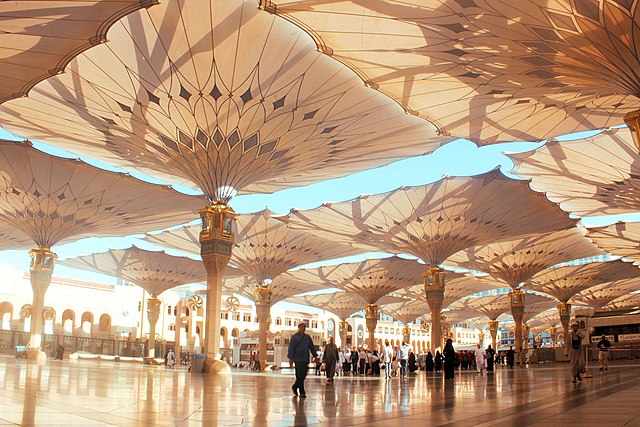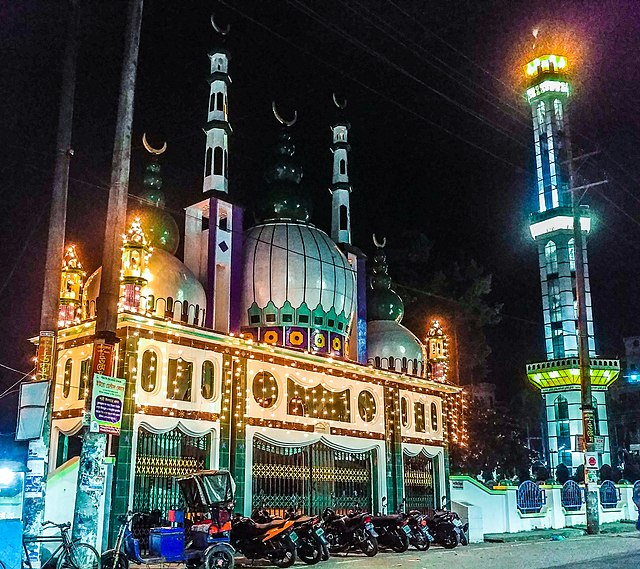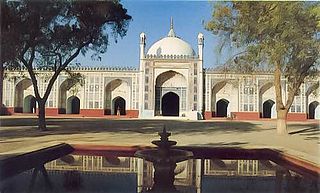Loading AI tools
South Asian term for an open-air Eid prayer enclosure From Wikipedia, the free encyclopedia
Eidgah or Idgah, also Eid Gah or Id Gah (Persian: عیدگاه "site of Eid [observances]"; Bengali: ঈদগাহ; Punjabi: عید گاہ; Urdu: عید گاہ; Hindi: ईदगाह) is a term used in South Asian Islamic culture for the open-air enclosure usually outside the city (or at the outskirts) reserved for Eid prayers offered in the morning of Eid al-Fitr and Eid al-Adha. It is usually a public place that is not used for prayers at other times of the year.[1] On the day of Eid, the first thing Muslims do in the morning is gather usually at a large open ground and offer special prayers,[2][3] in accordance with the Sunnah (traditions of Muhammad).[4] Although the usage of the term Eidgah is of Indian origin, it may be used for the musalla, the open space outside a mosque, or other open grounds where Eid prayers are performed, due to the lack of a specific Islamic term for a site of Eid observance. The Eidgah is mentioned in the famous Bengali poem by Kazi Nazrul Islam, O Mon Romzaner Oi Rozar Sheshe.



The first "Eidgah" was located at the outskirts of Medina nearly 1,000 footsteps from Masjid al Nabawi.[5], There are several scholarly opinions regarding praying at Eidgahs, prescribing it in the Sharia (Islamic law):

Notable Eidgahs around the world include
Shahi Eidgah, Quresh nagar (Delhi) India / Delhi / Delhi / When the Mughal Emperor Aurangzeb Alamgeer ascended the throne in the year 1658, he decided to build a big Eidgah, on the outskirts of then Shahjahanabad now known as the walled city.
Shahi Eidgah was built on an area of 31,484 square yards (26,325 m2) of land, surrounded by thousands of square yards of open maidan ( grounds ), which were also for the namazi.
The Shahi Eidgah complex has 283,257 sq ft (26,315.4 m2), which at any time can be used by 50,000 namazi. The main gate at the front side has also two small gates besides it for the entrance and exit of the devotees. The same pattern is followed on the north and south sides of the Shahi Eidgah.
The Moradabad Eidgah, Located near by Moradabad railway station. The prayer ground is very large, with a seating capacity of 20,000 attendees. It is a historical religious place for Muslims, thus local Moradabad Muslims perform Eid Namaz every year in this Eidgah.

Gor-E-Shahid Eidgah Maidan (Bengali: গোর-এ-শহীদ ঈদগাহ ময়দান) is located in Dinajpur. Sholakia is declared as the largest Eidgah in Bangladesh. But in Eid ul Adha of 2017 this Eidgah hosted the largest jamaat of Bangladesh. The number of devotees increased this year following the construction of a 516-foot wide minaret with 52 domes.[10] Eidgah Minar's main dome (Mehrab) is about 47 feet (14 m) high and 516 feet (157 m) wide. It has been built in 32 arches. Electric lamps have been connected to each dome of the Eidgah Minar. Eidgah Minar's beauty can be seen from many distances. The largest Eidgah Minar was constructed entirely with ceramic. The road is made for the devotees on both sides of the field. There will be adjacent arrangements. The Eidgah Minar is full of beauty when looked at from a distance. According to the district administration, the Eidgah has an area of about 22 acres (8.9 ha).[11] On the other hand, Sholakia's field is known to be 7 acres of land.[12]
In 2019, the 5thEid-ul-Fitr congregation was at Gor-e-Shahid Baro Maidan at 8:45am with the participation of 600,000 devotees.[13] Apart from members of other law enforcement agencies, over 500 policemen were deployed in and around the Eidgah to ensure security.[14] The 6th Eid-ul-Azha largest Eid congregation was at Gor-e-Shahid Baro Maidan, Dinajpur at 8:30am with the participation of around 4 lakh devotees.[15]
Eidgah Sharif is a Sunni Sufi shrine located in Rawalpindi, Pakistan.[16] The shrine was founded over a century ago. It welcomes visitors from all over the world and frequently hosts ceremonies known as Milaad Paaks which are mainly series of sermons from scholars and religious materials presented in solo a capella by people called "reciters". At the largest of these gatherings (such as the Urs Paak), more than a million visitors crowd the main grounds and the surrounding streets. About four million followers from all over the country and about 500,000 more from the United Kingdom are regular visitors to the shrine. The custodian of Eidgah Sharif, Shaykh Hafiz Muhammad Naqib-Ur Rehman, known to his followers as "Pir Sa’ab", advances the mission and teachings of Eidgah Shareef with the assistance of his son Sahibzada Muhammad Hassan Haseeb Ur Rehman, known to the devotees as "Sa’ab Ji". Pir Sa’ab's ancestors, the previous custodians of the shrine, were all said to be Sufi masters directly from the lineage of Mughal Emperor Babur. In 1960 the family gifted the government with a large proportion of the land used to build Pakistan's capital city of Islamabad, not far from Rawalpindi.[16]
Seamless Wikipedia browsing. On steroids.
Every time you click a link to Wikipedia, Wiktionary or Wikiquote in your browser's search results, it will show the modern Wikiwand interface.
Wikiwand extension is a five stars, simple, with minimum permission required to keep your browsing private, safe and transparent.